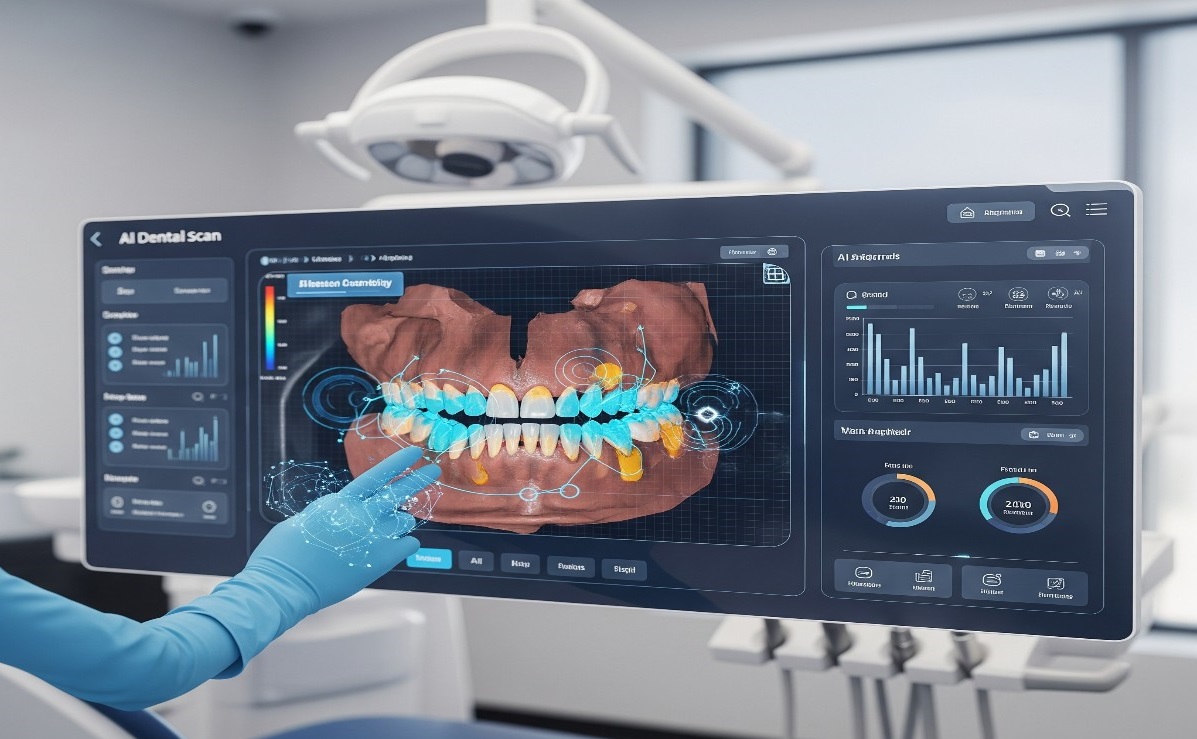

Imagine going to the dentist and getting your scan interpreted in front of you, revealing hidden problems before they become a major issue. It is possible with the use of AI in dentistry. With the use of AI in dental imaging, clinics are achieving faster, more accurate diagnoses and improved care with fewer errors.
From finding early cavities to bone topography mapping for implants, the Use of AI in dentistry is revolutionizing the delivery of oral healthcare. One of the best examples of such disruption is scanO, Overjet and Pearl, an AI-facilitated digital dental scanner that gives instant feedback on dental scans. All these contribute to building the future of dentistry, a scan at a time.
While with conventional methods, dentists have to greatly depend on their experienced eyes to identify issues, with AI dentistry, this is not necessary because it can cross-check intraoral scans, dental X-rays, and CBCT scans with machine precision. By cross-verifying patterns in large data sets, AI can identify warning signs of bone loss, tooth decay, and gum disease long before they would be identifiable using the assistance of a clinician.
This is where scanO surpasses. It uses AI to compare patient images to thousands of reference cases and marks suspicious regions in real time. Early detection then results in earlier interventions, and leads to better dental health.
Dental scans might be dense and full of detail. That's why one of the most useful strengths of AI in dentistry is improved segmentation. AI processing examines significant features such as bone density, nerves, and enamel and isolates them from the surrounding tissue. This allows dentists to focus on the relevant areas without being distracted by image noise.
scanO provides overlays that color-coded and make visible areas of potential trouble. This helps to better inform practitioners of diagnoses and inform patients as to what is occurring with their dental health.
Tending to dental problems requires a rapid and precise diagnosis. One of the greatest advantages of AI in dentistry is how rapidly it provides outcomes. Rather than waiting for lab results or reading scans manually, AI can report and examine in seconds.
scanO makes this easier by scanning, translating, and returning results in close to real time. This expediency allows dentists to work less on interpreting and more on explaining, healing, and reassessing patients.
Assisting CBCT and 3D Imaging
Advanced procedures like dental implants and orthodontics are founded on 3D scans and CBCT imaging. AI refines the accuracy of these devices with better images and auto-measuring.
Thanks to AI, dentists can now quantify distances to nerves, bone thickness, and treatment outcomes. This reduces the risk of surgery and enhances precision.
Every patient’s dental structure is unique. With advances in dental AI, treatment plans can now be tailored using a patient’s scan history, oral structure, and risk factors. AI spots tiny differences in anatomy and gives tailored recommendations.
This high degree of tailored planning serves to minimize trial and error in treatments such as aligners, implants, or bridges. scanO is beneficial in being receptive to real-time feedback and adjusting treatment protocols from newer scan data, forming dynamic care plans that change with every visit.
Human judgment is also inconsistent even after training and experience, particularly under fatigue and time pressure. That is where AI in dentistry becomes extremely important. AI acts as a dependable second reviewer to ensure that problems are not missed. It has constant attention and accuracy throughout every scan. scanO clinics have reported fewer missed cavities and small blemishes, showing enhanced safety and reliability in dental treatment.
The majority of patients are afraid of dental treatments simply because they have no clue what's going on. But AI is filling the gap. Using visual overlays, color-coded findings, and plain-English explanations, patients can now simply see themselves exactly where the areas of concern are within their scans.
By being able to utilize AI, including scanO, dentists can show patients the diagnosis and the treatment plan. It makes what seems mind-boggling into a possibility for engagement, enhancing compliance with treatment plans and empowering patients.
Though its benefits are numerous, AI in dentistry also comes with challenges that must be handled with sensitivity.
Data privacy: AI operates on large data sets, and individuals' health information has to be the highest priority.
Clinics need to make sure that AI systems such as scanO are not just in compliance with the data protection requirements.
The risk of over-reliance: Dentists themselves need to continue exercising clinical judgment. AI is a means to an end and not the end in itself.
Regulatory barriers: Not all markets have set rules regarding how to assess or deploy AI in dental care. Survival is required for frameworks to advance with innovation.
The future of AI in dentistry is bright. Here's an exclusive sneak peek at what's coming:
Augmented Reality (AR): AI-based AR technology will soon allow dentists to see nerve pathways and decay areas overlaid directly on the patient's mouth while operating on them.
3D-Printed Implants: AI-designed, 3D-printed dentistry implants will simplify difficult restorations.
Mobile AI Diagnostics: Smartphone technology will bring AI to rural health clinics and home screening, democratizing dental care.
Predictive Care Models: Future dental conditions will be predicted using AI based on lifestyle habits, biting patterns, and genetics, and preventive care will be provided even before they appear.
As these technologies come of age, AI dentistry will become even easier to use, hassle-free, and indistinguishable from regular dental practice.
Dentists' use of artificial intelligence isn't merely a future trend; it's a real, ongoing revolution in clinics today. From quicker image review and improved diagnoses to safer treatments and more intelligent treatment plans, AI is revolutionizing the delivery of dental care. It's assisting dentists in working more effectively, making better choices, and delivering more tailored care, changing the way we treat our oral health. With careful application of AI in dentistry, it has the ability to make a very significant impact on dental health.
scanO is an AI ecosystem transforming oral health for patients, dentists, corporates, and insurers worldwide

© 2025 Trismus Healthcare Technologies Pvt Ltd